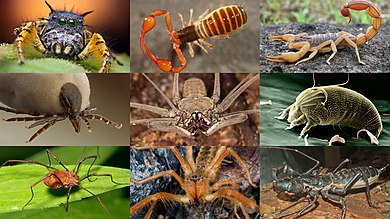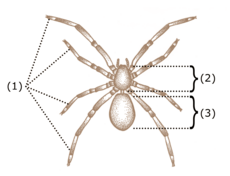Arachnid
The arachnids are a class of eight-legged arthropods.[1] They are a highly successful group of mainly terrestrial invertebrates: spiders,[2] scorpions, harvestmen, ticks, and mites, and a number of smaller groups.[3]
| Arachnids Temporal range: Early Silurian – present
| |
|---|---|

| |
| Left to right: Phidippus mystaceus (Araneae), Pseudoscorpion (Pseudoscorpiones), Hottentotta tamulus (Scorpiones), Ixodes ricinus (Ixodida), Heterophrynus (Amblypygi), Aceria anthocoptes (Trombidiformes), Harvestman (Opiliones), Galeodes caspius (Solifugae), and a Whip scorpion (Thelyphonidae). | |
| Scientific classification | |
| Kingdom: | Animalia |
| Phylum: | Arthropoda |
| Subphylum: | Chelicerata |
| Class: | Arachnida Lamarck, 1801 |
| Orders | |
| |
In 2019, a molecular phylogeny study put horseshoe crabs in the Arachnida.[4]
Definition
Arachnids are defined as coming from the class of Arachnida. The requirements for this class is to have two body regions; a cephalothorax and an abdomen; 4 pairs of legs; and 2 pairs of mouthpart appendages, the chelicerae and the pedipalps.[5]
Anatomy
All adult arachnids have four pairs of legs, and arachnids may be easily distinguished from insects by this fact, since insects have three pairs of legs. However, arachnids also have two further pairs of appendages that have become adapted for feeding, defense, and sensory perception. The first pair, the chelicerae, serve in feeding and defense. The next pair of appendages, the pedipalps have been adapted for feeding, locomotion, and/or reproductive functions.
Like all arthropods, arachnids have an exoskeleton. They also have an internal structure of cartilage-like tissue, to which certain muscle groups are attached.[6]
Arachnids have no antennae or wings. Their body is organized into two parts: the cephalothorax, and the abdomen.
Physiology
There are some adaptations for life on land. They have internal respiratory surfaces. These may be trachea (tubes), or a modification of gills into a 'book lung'. This is an internal series of lamellae used for gas exchange with the air.
Diet and Digestive System
Arachnids are mostly carnivorous, feeding on the pre-digested bodies of insects and other small animals. Only the harvestmen and some mites eat solid food particles. Predigestion avoids exposure to internal parasites.[7] Several groups secrete venom from specialized glands to kill prey or enemies. Several mites are external parasites, and some of them are carriers of disease (vectors).
Arachnids pour digestive juices produced in their stomachs over their prey after killing it with their pedipalps and chelicerae. The digestive juices rapidly turn the prey into a broth of nutrients which the arachnid sucks into a pre-buccal cavity located immediately in front of the mouth. Behind the mouth is a muscular, pharynx, which acts as a pump, sucking the food through the mouth and on into the oesophagus and stomach. In some arachnids, the oesophagus also acts as an additional pump.
Myth
The word Arachnida comes from the Greek for 'spider'. In legend, a girl called Arachne was turned into a spider by the goddess Athena. Arachne said she'd win a weaving contest against the goddess. Athena won, but Arachne became angry, and started to weave an insult to the gods. Then Athena turned her into a spider for her disrespect.
Orders
The subdivisions of the arachnids are usually treated as orders. Historically, mites and ticks were treated as a single order, Acari. However, molecular phylogenetic studies suggest that the two groups do not form a single clade; morphological similarities are probably due to convergence. They are now usually treated as two separate taxa – Acariformes, mites, and Parasitiformes, ticks – which may be ranked as orders or superorders. The arachnid subdivisions are listed below alphabetically; numbers of species are approximate.
- Acariformes – mites (32,000 species)
- Amblypygi – "blunt rump" tail-less whip scorpions with front legs modified into whip-like sensory structures as long as 25 cm or more (153 species)
- Araneae – spiders (40,000 species)
- †Haptopoda – extinct arachnids apparently part of the Tetrapulmonata, the group including spiders and whip scorpions (1 species)
- Opilioacariformes – harvestman-like mites (10 genera)
- Opiliones – phalangids, harvestmen or daddy-long-legs (6,300 species)
- Palpigradi – microwhip scorpions (80 species)
- Parasitiformes – ticks (12,000 species)
- †Phalangiotarbi – extinct arachnids of uncertain affinity (30 species)
- Pseudoscorpionida – pseudoscorpions (3,000 species)
- Ricinulei – ricinuleids, hooded tickspiders (60 species)
- Schizomida – "split middle" whip scorpions with divided exoskeletons (220 species)
- Scorpiones – scorpions (2,000 species)
- Solifugae – solpugids, windscorpions, sun spiders or camel spiders (900 species)
- Thelyphonida (also called Uropygi) – whip scorpions or vinegaroons, forelegs modified into sensory appendages and a long tail on abdomen tip (100 species)
- †Trigonotarbida – extinct (late Silurian to early Permian)
- †Uraraneida – extinct spider-like arachnids, but with a "tail" and no spinnerets (2 species)
- Xiphosura – horseshoe crabs (4 living species)[4]
It is estimated that 98,000 arachnid species have been described, and that there may be up to 600,000 in total.[8]
Images
Arachnid Media
"Arachnida" from Ernst Haeckel's Kunstformen der Natur, 1904
References
| Wikispecies has information on: Arachnida. |
- ↑ Ruppert E.E. Fo, R.S. and Barnes R.D. 2004. Invertebrate zoology 7 ed, Brooks/Cole. p520 ISBN 0030259827.
- ↑ Foelix, Rainer F. 1996. Biology of spiders. Oxford University Press. ISBN 0-19-509593-6.
- ↑ Schultz J.W. 2000. A phylogenetic analysis of the arachnid orders based on morphological characters. Zoological Journal of the Linnean Society 150: 221–265. [1][dead link]
- ↑ 4.0 4.1 Ballesteros J.A. & Sharma P.P. 2019. A critical appraisal of the placement of Xiphosura (Chelicerata) with account of known sources of phylogenetic error. Systematic Biology. 68 (6): 896–917. [2]
- ↑ "Class Arachnida | Department of Entomology". entomology.unl.edu. Retrieved 2021-01-20.
- ↑ Kovoor, J. (1978). "Natural calcification of the prosomatic endosternite in the Phalangiidae (Arachnida:Opiliones)". Calcified Tissue Research. 26 (3): 267–269. doi:10.1007/BF02013269. PMID 750069. S2CID 23119386.
- ↑ Pinto-da-Rocha R. Machado G. & Giribet G. 2007. Harvestmen — the biology of Opiliones. Harvard University Press ISBN 0-674-02343-9
- ↑ Chapman, Arthur D. (2005). Numbers of living species in Australia and the world (PDF). Department of the Environment and Heritage. ISBN 978-0-642-56850-2.
